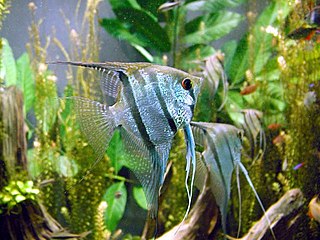
Cichlids are fish from the family Cichlidae in the order Cichliformes. Cichlids were traditionally classed in a suborder, the [Labroidei]], along with the wrasses (Labridae), in the order Perciformes, but molecular studies have contradicted this grouping. The closest living relatives of cichlids are probably the convict blennies, and both families are classified in the 5th edition of Fishes of the World as the two families in the Cichliformes, part of the subseries Ovalentaria. This family is both large and diverse. At least 1,650 species have been scientifically described, making it one of the largest vertebrate families. New species are discovered annually, and many species remain undescribed. The actual number of species is therefore unknown, with estimates varying between 2,000 and 3,000.
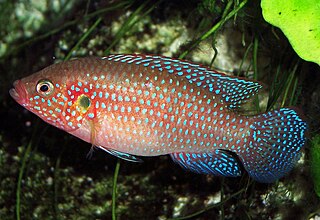
Hemichromis is a genus of fishes from the cichlid family, known in the aquarium trade as jewel cichlids. Jewel cichlids are native to Africa. Within West Africa, Hemichromis species are found in creeks, streams, rivers and lakes with a variety of water qualities including brackish water lagoons.
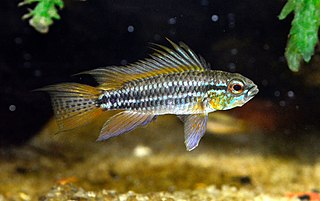
Apistogramma is a large genus of freshwater fish in the family Cichlidae found in South America, but also commonly kept in aquariums. They are dwarf cichlids that mostly feed on tiny animals and have breeding behaviors that vary depending on the exact species.

Neolamprologus brichardi is a species of cichlid endemic to the alkaline waters of Lake Tanganyika in East Africa. It is a popular aquarium fish kept in the fishkeeping hobby, where it is known under a variety of common names including Princess cichlid, Princess of Burundi, Lyretail cichlid, Fairy cichlid and Brichard's lamprologus. In addition, the species is also the subject of numerous studies on fish behaviour. It is closely related to N. pulcher from the southern half of Lake Tanganyika and some have recommended merging the two into a single species.

Julidochromis is a genus of cichlids in the subfamily Pseudocrenilabrinae. They are commonly called julies and are endemic to Lake Tanganyika in eastern Africa. This genus includes six formally described species, some with a number local variants of uncertain taxonomic status. Further taxonomic work is required to determine how many species exist; the closely related Chalinochromis with two more species is sometimes included here and this may be correct. Hybridization makes attempts to determine relationships with molecular phylogenetic methods difficult.

The blue ram, Mikrogeophagus ramirezi, is a species of freshwater fish endemic to the Orinoco River basin, in the savannahs of Venezuela and Colombia in South America. The species has been examined in studies on fish behaviour and is a popular aquarium fish, traded under a variety of common names, including ram, blue ram, German blue ram, Asian ram, butterfly cichlid, Ramirez's dwarf cichlid, dwarf butterfly cichlid and Ramirezi. The species is a member of the family Cichlidae and subfamily Geophaginae.
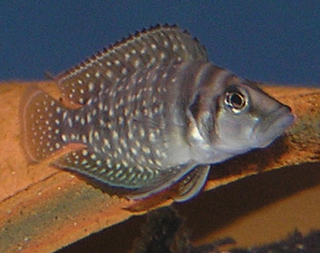
Altolamprologus is a small genus of pseudocrenilabrine cichlids endemic to Lake Tanganyika in eastern Africa. They inhabit areas of the lake with large amounts of rock, most frequently in water two to ten metres in depth. Two formally described species comprise this genus, with perhaps one dwarf A. compressiceps-like species being considered an unedescribed species by some.

Anomalochromis is a genus of fish in the family Cichlidae, containing the single species Anomalochromis thomasi, the African butterfly cichlid. It is a small cichlid growing to a length of 6–8 centimetres (2.4–3.1 in). The natural habitat of A. thomasi is Sierra Leone, Liberia and Guinea, mainly in smaller streams. The fish are typically found in slightly acidic, oxygen rich water with other west African cichlid genera such as Hemichromis and Pelvicachromis.

Pelvicachromis pulcher is a freshwater fish of the cichlid family, endemic to Nigeria and Cameroon. It is popular amongst aquarium hobbyists, and is most commonly sold under the name kribensis, although it has other common names, including various derivatives and color morphs of the kribensis: krib, common krib, red krib, super-red krib and rainbow krib, along with rainbow cichlid and purple cichlid.

Amatitlania sajica, the T-bar cichlid or Sajica cichlid, is a Central American species of cichlid found in freshwater streams and lakes on the Pacific slope of Costa Rica. The fish is tan colored with seven indistinct bars on the body. The third bar is usually prominent and coupled with a dark lateral stripe running from the gill cover results in a horizontal T-shaped mark, hence the common name of T-bar cichlid.

Pelvicachromis taeniatus is a species of cichlid from Benin and Nigeria that is occasionally kept as an aquarium fish. It is native to the soft-water rivers. This species can reach a length of 7.1 centimetres (2.8 in) SL. It is known to exist in a variety of geographically restricted varieties distinguished by differences in coloration. These are often given names such as "Nigerian red" or "Moliwe" that refer to the places where each variety is collected.
Kribensis refers to a number of West African fish of the genus Pelvicachromis, most commonly Pelvicachromis pulcher, Pelvicachromis subocellatus and Pelvicachromis taeniatus.

Synodontis is the largest genus of mochokid catfishes. It is the biggest genus within the 10 genera and 190 different species in the family Mochokidae. Synodontis has over 131 different species within the genus. Synodontis are also known as squeakers, due to their ability to make stridulatory sounds through their pectoral fin spines when handled or disturbed. Synodontis make a sound that sounds like squeaking by rubbing their spines together. They do this when they have been frightened or when they become angry. Synodontis may also squeak when they are taken out of the water. These catfish are small- to medium-sized fish with many species exhibiting attractive spotted markings. Some species are also known for naturally swimming belly-up, earning the name upside-down catfish. Some of these species are Synodontis contractus and Synodontis nigriventris. While some of these species are known to swim upside down, another species, Synodontis multipunctatus, is a brood parasitic cuckoo catfish.

Amatitlania septemfasciata is a fish species in the cichlid family. It is found on the Atlantic slope of Costa Rica, between the San Juan River drainage and the Banano River. Several currently recognized cichlid species within the genus Amatitlania were formerly considered varieties of Amatitlania septumfasciata, including Amatitlania myrnae, the Topaz Cichlid, and Amatitlania cutteri.

Chromidotilapiini is a tribe of small cichlids from tropical West and Middle Africa. There are thirteen genera and over fifty described species in this tribe.

Parananochromis is a genus of cichlids native to tropical Africa.

Pelvicachromis sacrimontis is a freshwater fish of the cichlid family known only from a small area of southeastern Nigeria.Currently Fishbase considers this binomial to be a junior synonym of P. pulcher and, it was also known as Pelvicachromis camerunensis, P. pulcher "form B" or P. sp. aff. pulcher but some authorities now consider it to be a vaild species. It is occasionally available in the tropical fish trade as "giant krib" and there are three colour morphs – red, green and yellow.

The redbelly tilapia, also known as the Zille's redbreast tilapia or St. Peter's fish, is a species of fish in the cichlid family. This fish is found widely in fresh and brackish waters in the northern half of Africa and the Middle East. Elsewhere in Africa, Asia, Australia and North America, it has been introduced as a food fish or as a control of aquatic vegetation. Where introduced, it sometimes becomes invasive, threatening the local ecology and species. The redbelly tilapia is an important food fish and sometimes aquacultured.
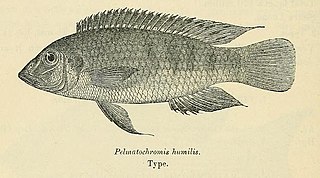
Wallaceochromis is a genus of fish in the family Cichlidae and subfamily Pseudocrenilabrinae endemic to West Africa. The name of this genus honours the British naturalist and coproponent of the theory of evolution through natural selection, Alfred Russel Wallace (1823–1913).
Pelvicachromis silviae is a species of cichlid in the genus Pelvicachromis. It is found in the Niger River, in the same region as congeners Pelvicachromis pulcher and Pelvicachromis taeniatus.



















